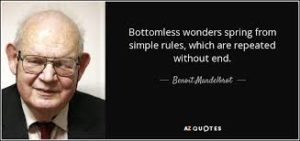In his 1802 book titled Natural Theology, or Evidences of the Existence and Attributes of the Deity Collected from the Appearance of Nature, Anglican Priest and philosopher William Paley made the classic teleological "argument from design" in his famous Watchmaker analogy, which says: In crossing a heath, suppose I pitched my foot against a stone, and asked how that stone came to be there; I might possibly answer that, for anything I knew to the contrary, it has lain there forever. Nor would it perhaps be very easy to show the absurdity of this answer. But suppose I have found a watch upon the ground, and it should be inquired how the watch happened to be in that place; I should hardly think of the answer, which I had before given, that for anything I knew, the watch might have always been there.... The watch must have had a maker: that there must have existed, at some time, and that some place or other, and artificer or artificers, who formed it for the purpose which we find it actually to answer; who comprehended its construction and designed its use.... Every indication of contrivance, every manifestation of design, which existed in the watch, exists in the works of nature; with the difference, on the side of nature, of being greater or more, and that in a degree which exceeds all computation. Granted, rebuttals have been attempted in response to Paley’s argument for Intelligent Design, but the question is: can these counterarguments actually challenge a modernized version of Paley's Watchmaker with any real success? It seems to me that all of these counterarguments … [Read more...]
GK-PID and the origin of species
Even though most biologists accept Darwin’s theory of natural selection as the explanation for how modern species came to exist, the mystery remains of how complex multicellular plants and animals evolved from far simpler single-celled organisms that rely on asexual reproduction to perpetuate their species. The offspring of single-celled organisms have the genes and DNA from only one parent, requiring no fusion of gametes or changes in the number of chromosomes. Single-celled organisms are independent creatures. The average human body contains anywhere between 60 and 90 trillion cells that cooperate and work in collaboration to function as bones, organs, and tissue. The biological processes and rules that governs the creation of DNA from two parent organisms are far more complex and require the development of new protein structures which single-celled organism neither have nor need and therefore should not be produced by asexual reproduction. However, recent research and experiments have suggested a protein structure named GK-PID facilitated evolution from ancient, ancestral single-celled organisms into more complex and modern creatures and humans. Christian beliefs regarding the origin of life vary from young earth creationism with an earth only 6,000 years old to old earth creationism, which finds no conflict between the Big Bang theory as the explanation for the origin of the universe and Genesis 1:3, which reads, “And God said, “Let there be light,” and there was light.” Christians may also believe that intelligent design or even theistic evolution best describes how … [Read more...]
Failure to communicate
I'm perfectly capable of having a polite yet spirited conversation with anyone about virtually any subject. I find the discussion tends to be far more interesting when two people seek common ground while exploring theoretical areas of disagreement. The potential to learn something new is far greater as ideas are freely exchanged, not banter dominated by memorized talking points that originated in some book written by somebody else. I write my own books. But it takes two to tango, as they say. Truly scintillating conversation ultimately depends on having a willing and worthy adversary for a vigorous debate. In any debate of interest both participants will clearly articulate their thoughts that have been steeped in logic and reason, without making appeals to emotion or resorting to regurgitated group-think. Both participants in an intellectual discussion must carefully listen to the opposition's point-of-view and make a serious attempt to understand it, if they hope to respond with cogent and effective rebuttal arguments. The problem is that in modern society, most people simply assume what another person thinks based on some preconceived label and would rather demonize and demagogue than persuade their opposition. Mere disagreement frequently inspires fits of apoplectic rage, and sometimes, even violence. Don't believe me? Just look at what's happened with the Berkeley riots. Interestingly, a college professor at Fresno State has also asserted that "college campuses are not free speech areas." The special snowflakes are encouraged to report their fellow students for … [Read more...]
Mandelbrot’s fractals
Patterns are models, or plans, used to produce nearly perfect copies of a specific design. In fact, the ability to discern a pattern from raw data is usually considered an indicator of advanced intelligence. Some scientists (who happen to be avowed atheists, and curiously not agnostic) will argue that when words like "models", "plans", and "design" are used to describe an organic, natural process, those words don't mean what they would ordinarily mean. These experts also claim the appearance of design in a living organism is nothing more than an overwhelmingly convincing optical illusion. In his book The Greatest Show on Earth: The Evidence for Evolution, biologist (and renowned atheist) Richard Dawkins wrote, Perhaps it was religious indoctrination that held us back (from believing in evolution). Or perhaps it was the daunting complexity of a living organ such as an eye, freighted as it is with the beguiling illusion of design by a master engineer. Why does Mr. Dawkins believe that our eyes have deceived us, and the intuitively obvious appearance of design in our bodies only an illusion? It's because he perceives design flaws in the human eye, probably due to the fact that the photoreceptor cells in the retina are allegedly placed backward. Dawkins has also been quite adamant about his belief that the vas deferens tube in humans and the laryngeal nerve in a giraffe are also examples of "poor" design which, as this website suggests, commits the logical fallacy of personal incredulity. This argument of Dawkins depends upon our making the assumption … [Read more...]
Iterative creation
[AUTHOR'S NOTE: Fourth installment in the series of articles originally published as the Atlanta Creationism Examiner about existential questions and the theory of evolution.] Iterative creation A new Facebook friend sent me a link to an article by a scientist advocating his version of Divine Evolution, another reason I now think iterative creation might have been a better name for my own personal philosophical beliefs. Stuart Kauffman wrote in the Edmonton Journal, I believe that we no longer need a Creator God, we need God's creativity. In other words, Kauffman believes in a form of theistic evolution ala Francis Collins, where we have a creator God who doesn’t really do anything but get the ball of evolution rolling, more deist than theist. Creation theory is concerned about the origin of things. If there is reason to believe that a supernatural entity of extraordinary intellect caused our universe to happen, why not believe that same Creator is directly responsible for the origin of life? Why would God put in all the work to set up the universe for life but lose interest before creating it? What exactly are we saying here? Do "we" believe that God suffers from some sort of Attention Deficit Disorder, or what? The so-called facts of evolution and the scientific evidence used to support my hypothesis of iterative creation are one and the same. The conjecture about evolution is where the theories significantly differ. Iterative creation begins with a bang. Actually, it begins with the Big Bang. The Big Bang Theory makes sense, mostly because scientific … [Read more...]



